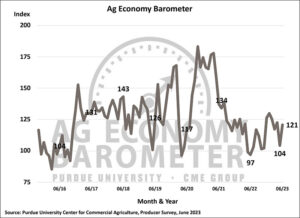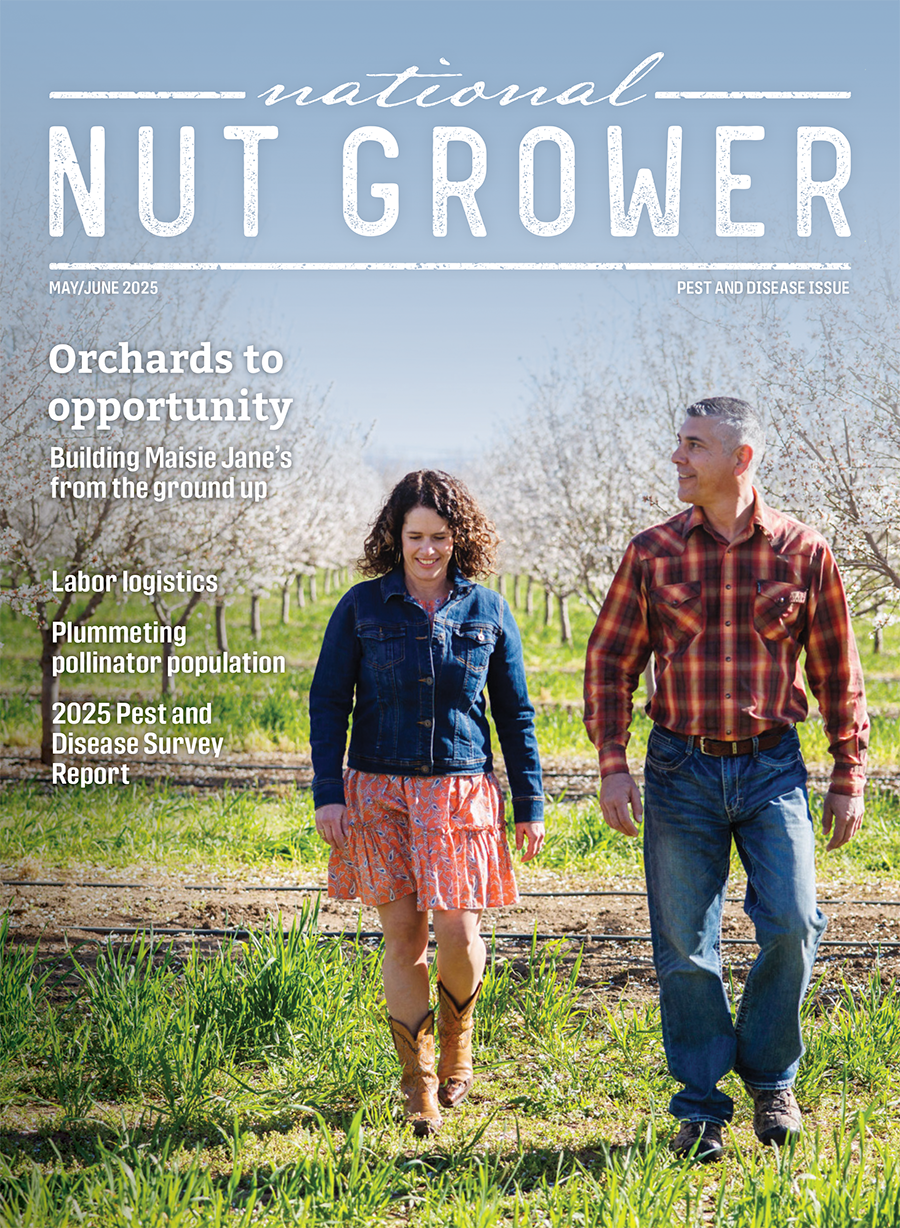Jul 5, 2023Farmer sentiment rebounds
The Purdue University/CME Group Ag Economy Barometer index improved in June, rising 17 points to a reading of 121. The upswing in sentiment was driven by producers’ more optimistic view of the future; however, the perception of current conditions remained unchanged from May.
Purdue University/CME Group Ag Economy Barometer
The Index of Future Expectations rose 25 points to a reading of 123, while the Index of Current Conditions held flat at a reading of 116 in June. The Ag Economy Barometer is calculated each month from 400 U.S. agricultural producers’ responses to a telephone survey. This month’s survey was conducted June 12-16.

“Optimism about U.S. agriculture’s future and a more sanguine interest rate outlook help explain producers’ more positive view of the future expressed in June’s survey; however current conditions in the farming economy continue to present a challenge for some producers,” said James Mintert, the barometer’s principal investigator and director of Purdue University’s Center for Commercial Agriculture. “This month four out of 10 producers stated that their financial situation has deteriorated compared to a year ago.”
To better understand the large month-to-month swing in producers’ expectations for the future, responses between the May and June surveys were compared.
In June, 20% of respondents said they expected their financial condition to improve over the next year, compared to just 13% who said that in May. Meanwhile, only 32% expect their farm’s financial situation to decline over the upcoming year, compared to 44% who responded that way in May.
Producers’ improved perspective on the future was not focused solely on their own farms, but extended to all of U.S. agriculture. The percentage of producers expecting good times for U.S. agriculture in the next five years rose 8 points to 33%, while the percentage of producers expecting bad times fell 3 points to 41%.
The Farm Financial Performance Index also rose this month, up 10 points from May, and was likely a result of a late-May to early-June rally in harvest-time prices for corn and soybeans, as well as optimism toward positive returns for cattle producers. In June, 50% of respondents said they expect “good times” for livestock producers in the next five years, up from 37% in May. Optimism about positive returns for cattle producers, especially cow-calf operations, was likely a key factor behind the positive livestock outlook.
The Farm Capital Investment Index rose five points in June to a reading of 42; however, nearly 75% of respondents still feel now is a bad time to make large investments in their farming operation. Respondents in June cited rising interest rates (35% of respondents) and increasing prices for equipment and new construction (37% of respondents) as key reasons for viewing now as a bad time for investments.
Producers were more optimistic about farmland values in June as both the short and long-run farmland value indices rose. The short-term index, which asks producers about their outlook over the next 12 months, jumped 16 points to a reading of 126, its highest reading since last November. Meanwhile, the long-term index, which asks producers to look ahead five years, rose a more modest 6 points to a reading of 151, pushing that index up to its highest level since February 2022. Additionally, 43% of producers in the June survey think interest rates have peaked, and nearly a quarter of survey respondents expect to see lower interest rates within the next year.
This month’s survey also included a question targeted toward corn and soybean producers regarding their expectations for farmland cash rental rates in 2024. Twenty-five percent of the corn/soybean producers in this month’s survey said they expect 2024 cash rental rates in their area to rise above 2023’s rates. Of those respondents who said they expect rental rates to rise, nearly one-third (32%) said they expect 2024 rental rates to increase up to 5%, while nearly half (49%) look for rates to rise from 5% to 10%, when compared to 2023.
This month’s survey included questions to learn more about producers’ thoughts on the passage of a new farm bill. Among corn and soybean producers, the Crop Insurance title and the Commodity title remain the two most important farm bill components. When asked about expectations for PLC reference prices for corn and soybeans, half of corn and soybean producers said they expect Congress to raise prices for both. In response to the recent Supreme Court ruling, which upheld California’s Proposition 12 mandating housing standards for hogs processed into pork that will be sold in that state, all survey respondents were asked about the likelihood Congress would overturn the proposition as part of a new farm bill. Producers were split in their response to this question, with 36% stating it’s either somewhat or very unlikely that Congress will try to overturn the proposition, and 25% stating it is at least somewhat likely Congress will take on Proposition 12 in new farm bill legislation.
Read the full Ag Economy Barometer report at https://purdue.ag/agbarometer. The site also offers additional resources – such as past reports, charts and survey methodology – and a form to sign up for monthly barometer email updates and webinars.
Each month, the Purdue Center for Commercial Agriculture provides a short video analysis of the barometer results. For more information, check out the Purdue Commercial AgCast podcast, which includes a detailed breakdown of each month’s barometer and a discussion of recent agricultural news that affects farmers.
The Ag Economy Barometer, Index of Current Conditions and Index of Future Expectations are available on the Bloomberg Terminal under the following ticker symbols: AGECBARO, AGECCURC and AGECFTEX.
Purdue University Center for Commercial Agriculture
The Center for Commercial Agriculture was founded in 2011 to provide professional development and educational programs for farmers. Housed within Purdue University’s Department of Agricultural Economics, the center’s faculty and staff develop and execute research and educational programs that address the different needs of managing in today’s business environment.
CME Group
As the world’s leading derivatives marketplace, CME Group (www.cmegroup.com) enables clients to trade futures, options, cash and OTC markets, optimize portfolios, and analyze data – empowering market participants worldwide to efficiently manage risk and capture opportunities. CME Group exchanges offer the widest range of global benchmark products across all major asset classes based on interest rates, equity indexes, foreign exchange, energy, agricultural products and metals. The company offers futures and options on futures trading through the CME Globex® platform, fixed income trading via BrokerTec and foreign exchange trading on the EBS platform. In addition, it operates one of the world’s leading central counterparty clearing providers, CME Clearing.
CME Group, the Globe logo, CME, Chicago Mercantile Exchange, Globex, and E-mini are trademarks of Chicago Mercantile Exchange Inc. CBOT and Chicago Board of Trade are trademarks of Board of Trade of the City of Chicago, Inc. NYMEX, New York Mercantile Exchange and ClearPort are trademarks of New York Mercantile Exchange, Inc. COMEX is a trademark of Commodity Exchange, Inc. BrokerTec and EBS are trademarks of BrokerTec Europe LTD and EBS Group LTD, respectively. The S&P 500 Index is a product of S&P Dow Jones Indices LLC (“S&P DJI”). “S&P®”, “S&P 500®”, “SPY®”, “SPX®”, US 500 and The 500 are trademarks of Standard & Poor’s Financial Services LLC; Dow Jones®, DJIA® and Dow Jones Industrial Average are service and/or trademarks of Dow Jones Trademark Holdings LLC. These trademarks have been licensed for use by Chicago Mercantile Exchange Inc. Futures contracts based on the S&P 500 Index are not sponsored, endorsed, marketed or promoted by S&P DJI, and S&P DJI makes no representation regarding the advisability of investing in such products. All other trademarks are the property of their respective owners.









